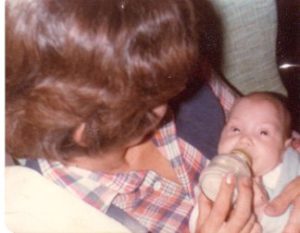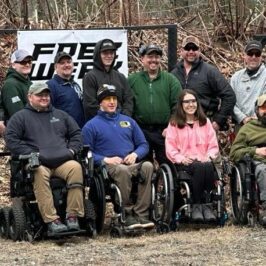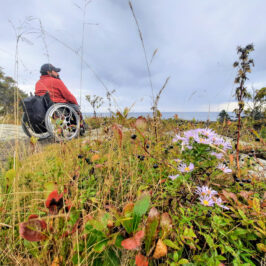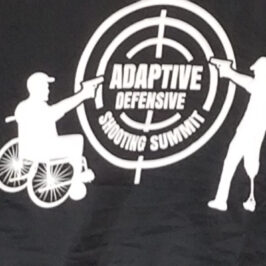The Reason For My Writing
In the past couple years, I have been a member of Greater Portland Toastmasters. I joined Toastmasters because I am trying to become a public speaker as a profession. As part of the learning process I am now at the point where I need to do a speech about something I have researched. It occurred to me that I know very little about Spina Bifida even though i live with it everyday. I decided that should be my topic, but I got a little carried away. This is way too long for a 5-7 minute speech. I did not want to waste all this information though so I am posting it as a blog and will just have to whittle it down for my speech. I started out just looking up facts. I eventually found an article by a doctor named Lisa J. Pruitt called “Living with Spina Bifida: A Historical Perspective.” When I read this it brought actual tears to my eyes. I cannot believe how lucky I truly am. I have tried to paraphrase where I could, but some information is taken directly from the article. I have added bits and pieces of my life to add my own perspective. So, sit back relax and read on for your learning pleasure!
A Little About Me
I was Born on July 27th, 1978 with a birth defect called spina bifida. I have the worst kind called myelomeningocele. Which I still cannot spell without spell check haha. You may think that since I have this birth defect that I would be an expert on the topic. Until now I knew very little about it. I guess it was just always who I am and not really my focus in life. As a person with a disability I have many friends who are spinal cord injured. Over the years observing them, I realized they knew everything about their diagnosis, and I knew nothing about mine. I think the difference is that they were injured and went to rehab. In rehab they teach you all the things you need to know to live your new “normal”. When I was born no one taught me anything. I just grew up and lived my life adapting to my world and situation.
Your Son Has 3 Months To Live
The day I was born they immediately rushed me to Maine Medical Center for a lifesaving surgery. Along with Spina Bifida babies can also be stricken with something called Hydrocephalus. This is a condition where the fluid in the brain continues to build up because it cannot be drained by the spinal cord. After an extensive surgery to install a tube in my head called a shunt, to drain the fluid, the first thing my parents heard from the doctor was “your son has 3 months to live.” I got lucky and the doctors were wrong. Unfortunately, not everyone born with spina bifida is so lucky.
The History of Spina Bifida
According to the paper I read by Lisa J. Pruitt PhD called “Living with Spina Bifida: A Historical Perspective”, it was not that long ago in our recent history that doctors believed a child born with spina bifida may be better off dead than alive,
Before 1960
Before 1960 the survival rate of babies born with Spina Bifida was around !0% to 12%. Surgeons would usually put off treatment until the age of 2 because they believed only the strongest babies would survive. Before antibiotics came along in the 1940s most of the babies lost their lives due to spinal meningitis. I also had spinal meningitis and still survived because of treatment. Those who managed to survive in the 1950s ended up with renal complications. In the 1960s procedures were developed to mitigate the renal problems.
The 60s
By the mid-60s things started to improve with better treatments but the bias of doctors toward those with disabilities was still rampant. In 1967, W.J.W. Sharrard, Robert Zachary, and John Lorber, pediatric surgeons at Children’s Hospital, Sheffield, UK, reviewed the cases of 526 children born between 1955 and 1962 and treated for myelomeningocele. They concluded that there was “no place for the selection of patients for conservative treatment rather than operative treatment on the grounds of paralysis, deformity or hydrocephalus present at birth.” As a result of this and similar studies published in the mid-1960s, most centers in the United Kingdom and United States adopted the practice of operating within 12 to 48 hours of birth on all infants who did not have other defects incompatible with life.
Mr. Zachary became the voice of optimism for children with myelomeningocele. He realized that the social environment shaped the experience of disability and that questions about treatment were really questions about the place of people with disabilities in society. Acknowledging the unrealized potential of children with myelomeningocele, Zachary maintained that “extreme disability is not synonymous with unhappiness and we are only at the beginning of finding ways of developing the capabilities of these patients.”
Enocks Perspective
I can truly attest to that last statement by Zachary. Disability does not necessarily mean lack of quality of life. It just means a different way of experiencing life. In the end we all experience life differently.
The 70s
Later In 1971, John Lorber, reversed his position. Based on what he viewed as the poor quality of life of children with myelomeningocele, Lorber argued for not treating most infants with the defect. Instead he wanted to treat only the most viable babies. He believed that the majority of children born with myelomeningocele would as he put it,” have very few or no friends; most are left without jobs, they have no chance of love or marriage, and when their exhausted parents can no longer cope, they will end their days in an institution.” Rejection by the able-bodied world, in Lorber’s view, justified nontreatment.
Enocks Perspective
Granted I have found it difficult to find a long-lasting job. I have had a few jobs over my lifetime, but medical issues almost always seem to get in the way. I have found love and my parents were and are the most supportive people in my life. I did not end up in an institution.
Criteria to Decide Who LIves
After arriving at this viewpoint Lorber developed a set of criteria to decide which lives would be worth saving. This criterion was widely adopted in the 70s and 80s but there was a small group of doctors who outright rejected it. They argued that it would be a denial of ordinary care. One of the criteria Lorber recommended was to not give antibiotics and to heavily sedate infants so they would not cry to be fed. Essentially ending their lives by starvation. The doctors who did not follow this criterion ended up with patients who survived but were much more severely disabled due to no treatment at all.
WTF (AKA Enocks Perspective)
This next part I cannot even believe. As I said I was born in 1978. The debate of whether to treat patients with myelomeningocele lasted well into the 1980s. Years after my birth there were people in the world still trying to decide if my life was worth saving.
Baby Jane Doe
A famous story of “Baby Jane Doe” who was born October 11. 1983 in Port Jefferson, NY illustrates just how the debate dragged on. She was diagnosed with hydrocephalus and myelomeningocele, the most common and serious form of spina bifida. Doctors advised her parents that she would die without surgery. With surgery, she would live from 2 to 20 years,.
Iam now 41.
They said she would be paralyzed, bedridden, incontinent, and severely “retarded.” Based on this information, the parents declined treatment. Baby Jane survived however, to become a self-fulfilling prophecy; because she was predicted to have brain damage, surgery was withheld, resulting in damaging infections that might have been avoided with early aggressive treatment. Subsequent litigation and media coverage concerning Baby Jane Doe focused on the issue of “quality of life.” You can read more about her here: Baby Jane Doe Wikipedia
Thank You for Saving Me
It really is somewhat of a miracle that I had the right doctor. Dr. Ronald Blum, the right parents, good insurance, and a multitude of other things fall in place to help guarantee my survival. Not unlike today with the current coronavirus situation, where people are deciding who is too old to be treated or who deserves to live, I could have had the same fate. I truly appreciate all the doctors, nurses, first responders, and all the amazing people in my life who helped make my life possible.
For more detail on the history of Spina Bifida check out the link below!
Sources: https://www.ncbi.nlm.nih.gov/pmc/articles/PMC3408685/
My life






Leave a Reply